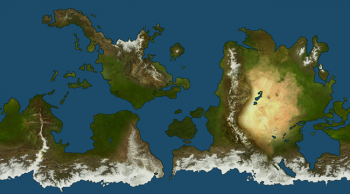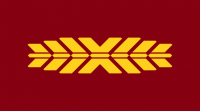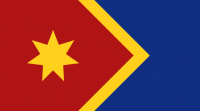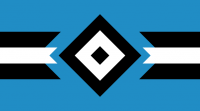Carnassus: Difference between revisions
m (→Carnassus) |
m (→Carnassus) |
||
| Line 17: | Line 17: | ||
Carnassus is composed of two major landmasses. One of which is a continental island, while the other forms a nearly continuous ring around the planet. This ring is broken up by mountain ranges, and also an inlet to the Southren Sea. However, due to the mountain ranges, intervening bodies of water and such, the planet is said to contain five continents which are described more fully below. Carnassus contains three oceans, and one large intercontinental sea which are also described more fully below. | Carnassus is composed of two major landmasses. One of which is a continental island, while the other forms a nearly continuous ring around the planet. This ring is broken up by mountain ranges, and also an inlet to the Southren Sea. However, due to the mountain ranges, intervening bodies of water and such, the planet is said to contain five continents which are described more fully below. Carnassus contains three oceans, and one large intercontinental sea which are also described more fully below. | ||
[[File:Carnassus-names.png|left|400px|thumb|A | [[File:Carnassus-names.png|left|400px|thumb|A map of Carnassus with placeholder names for its regions.]] | ||
=== Continents === | === Continents === | ||
The two major landmasses of Carnassus are broken up into five continental regions. The borders are mainly composed of large mountain ranges where two continental plates meet. The continents are currently named after their corresponding locales in the "real world": on the northern landmass, there are Atlantica, Norwegia, the Mediterranean Islands and Hudson; on the southern ring landmass, there are the Pacifican Expanse, Indica, the island of Nazca and South Atlantika. There is another "continent" which lies to the west of the mountain chain running north-south across the Pacifican Expanse which is presently known as the Polynesian Fringe. The most prominent feature on Hudson is the active volcano. On Atlantica, there is a large mountain range to the northwest which makes up its border with Norwegia. South Atlantica, which makes up three sides of a bay, lies to the south of Atlantica (naturally). To the west of that is a large mountain range coming up from the south. This range divides South Atlantica from Indica. The island of Nazca, a part of the Polynesian Fringe, lies between the Pacifican Expanse and South Atlantica. On the opposite side of the world, Indica wraps around the edge of the map to form the other side of the Austy Sea. | The two major landmasses of Carnassus are broken up into five continental regions. The borders are mainly composed of large mountain ranges where two continental plates meet. The continents are currently named after their corresponding locales in the "real world": on the northern landmass, there are Atlantica, Norwegia, the Mediterranean Islands and Hudson; on the southern ring landmass, there are the Pacifican Expanse, Indica, the island of Nazca and South Atlantika. There is another "continent" which lies to the west of the mountain chain running north-south across the Pacifican Expanse which is presently known as the Polynesian Fringe. The most prominent feature on Hudson is the active volcano. On Atlantica, there is a large mountain range to the northwest which makes up its border with Norwegia. South Atlantica, which makes up three sides of a bay, lies to the south of Atlantica (naturally). To the west of that is a large mountain range coming up from the south. This range divides South Atlantica from Indica. The island of Nazca, a part of the Polynesian Fringe, lies between the Pacifican Expanse and South Atlantica. On the opposite side of the world, Indica wraps around the edge of the map to form the other side of the Austy Sea. | ||
Revision as of 23:31, 27 December 2017
Far into the future on the Earth we know and love (at least insofar as it sustains us), there have been vast technological advances. The Earth no longer suffers from a surplus of greenhouse gasses, the human-created warming of the Earth and melting of the icecaps have been halted (and even reversed in some places), and the distribution of food and wealth have become far more efficient and equitable for the past (almost) century. If this sounds like some sort of quasi-utopia, well, you'd be at least mostly right. (Somewhat.) However, there has also been a boon in the sciences of AI development, and perhaps the most amazing thing that has been done is the creation of machines that can interface directly with a human's mind and take commands directly from their neural output. While this has allowed some truly amazing things with 3D and alternate reality gaming... it has also paved the way for some other inventions as well. And this, is where our story picks up...
 | |
|---|---|
| Carnassus Kaląsnao / Cárangdhot / Tạllnaas | |
| Pronounced: | English: /kaɻ.næ.səs/ Islhontish: /kɑ.lə̃s.nɑʊ̯/ Vingdagese: /kaː.raŋ.ðod/ Shitullian: /tæʟ.nəːs/ |
| Languages Spoken: | Islhontish, Vingdagese, Shitullian, Dahoukki, etc. |
| Lifeform Information | |
| Dominant Species: | Human |
| Human Population: | 37,000,000 (approx.) |
| Other Fauna: | Dinosaurs, Giant hyenas, Walking whales |
| Other Flora: | Palms, Ferns... |
| Astronomical Information | |
| Average Solar Distance: | 149,597,500 km |
| Planetary Circumference: | 40,075 km |
| Equatorial Diameter: | 12,756 km |
| Planetary Area: | Land: Unknown Water: Unknown |
| Axial Tilt: | 23˚ |
| Satellites | |
| Satellites: | Natural: Luna Artificial: Somnis |
| Credits | |
| Creator: | Thrice Xandvii | ✎ |
| Created: | December 2014 |
The Dream Engine
One dabbling scientist who was a leader in his field of science dealing with the aforementioned neural interfaces happened to have a friend who was a leader in his field of terraforming technology. This is the same tech that was used to colonize Mars and make portions of the Moon hospitable to human settlements. A third scientist, who it would be a stretch to call a friend, happened to be developing some tech that could allow some limited reality warping. And when I say limited, I mean that he had purposefully implemented a ton of safeguards to assure that his experiments didn't get out of hand. He was able to manipulate matter on the quantum level and shift and mold it to within the stated parameters. Think of the matter creating technology of a holodeck on Star Trek but with the Fullmetal Alchemist-esque proviso that matter cannot be made, simply altered and that in order to make something, something of equal value must be exchanged.
One of this last scientist's assistants was not exactly the most careful or scrupulous dude you'd ever met, but she did have the knowledge that the previous two scientists and their work was stored in a database that was secured by the same data storage center that stored all of the scientist's work that she herself worked for. So, with all that combined knowledge in one place, she was able to crack through the security of said database, and pilfer the combined resources of all three incredible scientific minds. Now, with food, money, space, and climate being non-issues, she set her sights much much higher. She wanted to craft a machine that could interface with a mind and then create in reality those exact desires! After years of hiding out and dodging the inquiries of any who might try to suss out what she was up to, she was finally able to create what she liked to refer to as the Dream Engine. A bit hokey, maybe, but she felt like it summed up everything about it that she wanted it to be. Oh... did I happen to mention that this chick put her machine on an orbital station rotating in opposition to the moon? No? Well, that's likely an important detail.
On one fateful day of testing and re-configuring the surrounding environment to her wishes, she went a little bit mad with excitement and decided to turn off all but one safeguard: the one that stopped the machine from killing any Homo sapiens. However, with all of those safeguards off... and her mind alight with ideas and images of everything that this most perfect of machines could do, it is a surprise to no one that things didn't go exactly as planned.
With but one thought, and an entirely too vague one at that, the machine went to work changing all the water to land, all the land to water. It killed every living species on the planet that wasn't a human, and resurrected a scad of those that had been extinct for milenia... But, of course, it couldn't just make something from nothing. So, the earth was moved and shaped and sunk and raised in order to give us the map shown below. It's not perfect, as no machines made by man are, and of course the water isn't all as backward as one expects... but it is what the Dream Engine made it.
Now, one asks, what is the population of the world like? What happened to all these people that the machine couldn't kill? And what influence will their languages of origin have when tossed into this strange new world? Well... the machine also had something to say about population density. Since numbers can't be made opposite, it did however decide that the population density must be vastly smaller by attempting to make sure that centers of population on the old world were devoid of human life on the new one. Oh, and everyone that didn't fit in the new schema? Well, they are in hibernation on the once colonized terraformed side of the moon. All humans, including the female assistant who has yet to be named, had their minds wiped so that what had been full... was now empty. That includes, of course, all the people that got plopped down in the various settlements across the world. A feature that makes all Carnassians on equal (and strange) linguistic and mnemonic footings.
Carnassus
Carnassus is composed of two major landmasses. One of which is a continental island, while the other forms a nearly continuous ring around the planet. This ring is broken up by mountain ranges, and also an inlet to the Southren Sea. However, due to the mountain ranges, intervening bodies of water and such, the planet is said to contain five continents which are described more fully below. Carnassus contains three oceans, and one large intercontinental sea which are also described more fully below.
Continents
The two major landmasses of Carnassus are broken up into five continental regions. The borders are mainly composed of large mountain ranges where two continental plates meet. The continents are currently named after their corresponding locales in the "real world": on the northern landmass, there are Atlantica, Norwegia, the Mediterranean Islands and Hudson; on the southern ring landmass, there are the Pacifican Expanse, Indica, the island of Nazca and South Atlantika. There is another "continent" which lies to the west of the mountain chain running north-south across the Pacifican Expanse which is presently known as the Polynesian Fringe. The most prominent feature on Hudson is the active volcano. On Atlantica, there is a large mountain range to the northwest which makes up its border with Norwegia. South Atlantica, which makes up three sides of a bay, lies to the south of Atlantica (naturally). To the west of that is a large mountain range coming up from the south. This range divides South Atlantica from Indica. The island of Nazca, a part of the Polynesian Fringe, lies between the Pacifican Expanse and South Atlantica. On the opposite side of the world, Indica wraps around the edge of the map to form the other side of the Austy Sea.
Oceans & Seas
There are three main oceans on Carnassus, and several prominent seas and inlets. In the center of the map lies an intercontinental sea that surrounds Nazca. It is called the Sudamican Sea, which takes its name from South America in our reality. To the north, is the Nortamican Ocean (with a similar etymology), which contains the isle of Hudson. To the west of that, and north of Norwegia, lies the Greenlandic Sea. The Mediterranean Isles makes up the border between the African and Asian Oceans. Off of the African Ocean is the Madagascan Inlet. To the extreme south on the map lies a polar sea: the Southren Sea. This sea is fully enclosed by land on all but its one inlet from the Sudamican Sea (which might be renamed into an ocean itself). Finally, is the Austy Sea which serves as part of the border between the Pacifican Expanse and Indica.
Climate
Cultures
There are many cultures that live across the lands of Carnassus. However, the most prominent ones are discussed below with links to their respective languages as well.
Islhontians
Name
History
Language
Islhontians speak, in a romanization of their native spelling, a language by the name of Isλǫtaλao.
Flag
Culture
The Vingdagese
Name
History
Language
The Vingdagese speak a language that they call Vưng-Ḍác Tǫ.
Flag
Culture
Shitullians
Name
History
Language
Śitaall (spellt in a romanization of their native script) is the language spoken by Shitullians.
Flag
Culture
Dahoukki
Name
History
Language
The inhabitants of the Dahoukki lands speak a language that is also anglicized as Dahoukki. They refer to it as Dŭhog. This name is sometimes spellt with an extra u to emphasize the fact that the second vowel is not "short."
Flag
Culture
Gnutzikans
Name
History
Language
Gnutzikans speak a language that is usually rendered as Gnütșziķ. Their language is natively written in a runic script with optional vowel glyphs.
Flag
Culture
Author's Notes
This conplanet is one that has been in my thoughts for a long time. However, I am just now recording details about it toward the end of 2017. As I write this, the planet is very much in a fledgling state with almost nothing in the way of climate... or even where each individual culture is going to be placed. As such, there is sort of a wall that exists preventing much development beyond a certain point. Unfortunately, I am beginning to reach that point.





